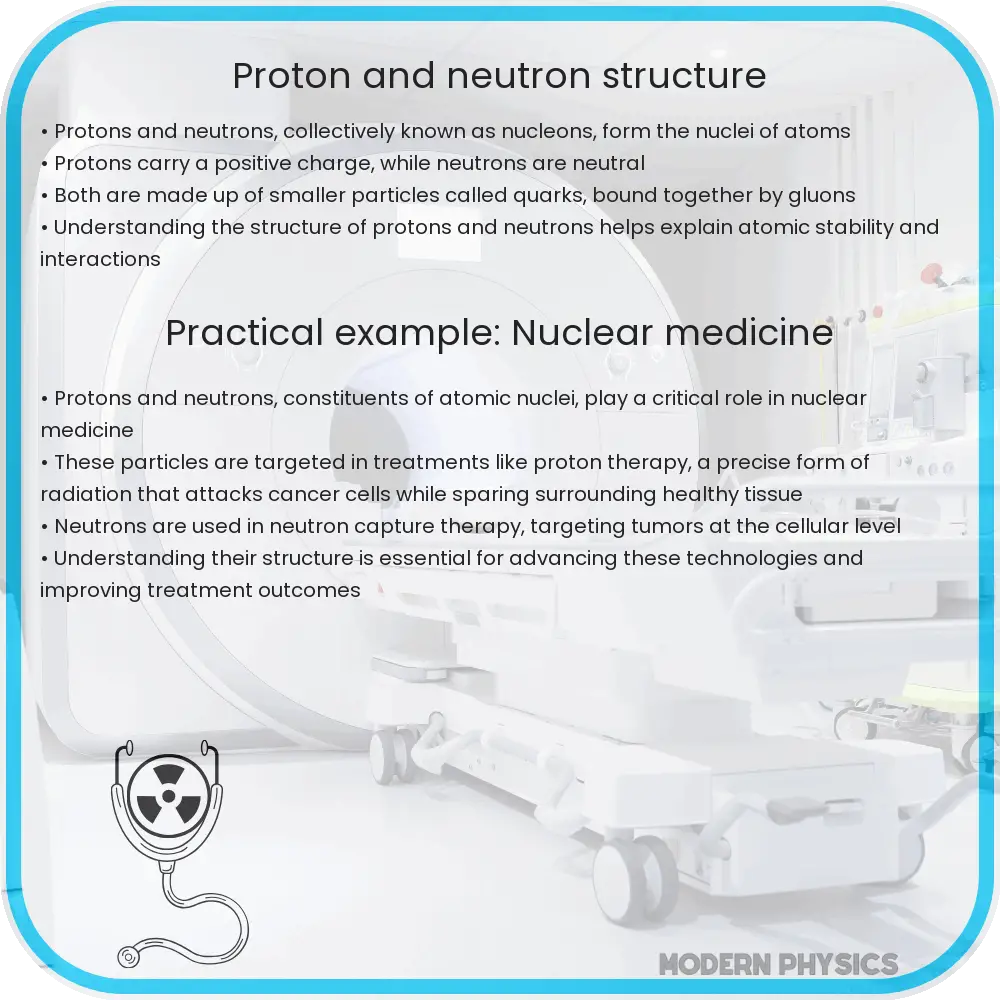Explore the complex structure of protons and neutrons through Quantum Chromodynamics, revealing quark dynamics and the strong force in nucleons.

Understanding the Intricacies of Proton and Neutron Structure: Insights from Quantum Chromodynamics
The world of subatomic particles is a realm of complex interactions and fascinating behaviors, significantly characterized by protons and neutrons. These nucleons, which constitute the nucleus of an atom, are more than just fundamental building blocks; they are dynamic systems governed by the principles of Quantum Chromodynamics (QCD). This article delves into the intricate structure of protons and neutrons, exploring the role of quarks, the forces that bind them, and the profound implications for our understanding of the universe.
Quark Composition and Interactions within Nucleons
Protons and neutrons are composite particles made up of quarks, the fundamental constituents of matter in the standard model of particle physics. A proton is composed of two ‘up’ quarks and one ‘down’ quark (uud), while a neutron consists of one ‘up’ quark and two ‘down’ quarks (udd). These quarks are held together by the strong force, mediated by particles known as gluons. The interaction between quarks and gluons is described by Quantum Chromodynamics (QCD), a theory that explains how the strong force operates at the subatomic level.
Quantum Chromodynamics: The Force Behind the Binding
QCD is a fundamental theory in the standard model, describing the interactions between quarks and gluons. It posits that quarks carry a property called ‘color charge’, analogous to the electric charge in electromagnetism, but with three types: red, green, and blue. Gluons, the exchange particles of the strong force, bind these quarks together, ensuring the stability of protons and neutrons. Unlike electromagnetism, where like charges repel, in QCD, color charges attract each other, creating an incredibly strong bond between quarks.
Binding Energy and the Stability of Nucleons
The concept of binding energy is crucial in understanding nucleon stability. Binding energy refers to the energy required to separate a nucleon into its constituent quarks. This energy is a direct consequence of the strong force and is significantly higher than the energies involved in electromagnetic interactions. The immense binding energy within protons and neutrons ensures their stability, making them the primary building blocks of atomic nuclei.
In the next part, we will explore the implications of QCD on the mass and size of nucleons, the phenomena of quark confinement, and how these insights have deepened our understanding of the universe at its most fundamental level.
Mass and Size of Nucleons: The Role of QCD
One of the most intriguing aspects of QCD is its role in defining the mass and size of nucleons. Contrary to intuitive assumption, the mass of a proton or neutron is not merely the sum of its constituent quarks’ masses. Instead, a significant portion of the nucleon’s mass arises from the dynamic energy of the quarks and gluons interacting within it. This phenomenon is a direct consequence of Einstein’s equation, E=mc2, where the energy of the strong force contributes to the overall mass. Furthermore, the size of nucleons, typically about 0.8 to 1 femtometer, is determined by the range of the strong force mediated by gluons.
Quark Confinement: A Peculiarity of QCD
Another fascinating aspect of QCD is quark confinement. Unlike other particles, quarks are never found in isolation. This unique property, known as confinement, arises because the force between quarks does not diminish with distance, unlike the electromagnetic force. When quarks are pulled apart, the energy in the gluon field increases, eventually leading to the creation of new quark-antiquark pairs, which prevents the isolation of individual quarks. This characteristic of QCD has profound implications for our understanding of particle physics and the fundamental structure of matter.
Implications and Future Perspectives
The insights provided by QCD have not only deepened our understanding of the fundamental particles like protons and neutrons but also opened up new avenues for research in particle physics. Experiments at large hadron colliders continue to test the predictions of QCD, exploring higher energy realms and the conditions similar to those of the early universe. These studies are crucial for advancing our knowledge of how the universe works at the most fundamental level.
Conclusion
Quantum Chromodynamics has revolutionized our understanding of the subatomic world. By elucidating the structure and dynamics of protons and neutrons, QCD has provided a more comprehensive view of the forces and interactions that govern the universe’s building blocks. As research continues to unveil the mysteries of quark dynamics and the strong force, our comprehension of the natural world becomes ever more profound, reinforcing the significance of QCD in the broader context of particle physics and cosmology.
